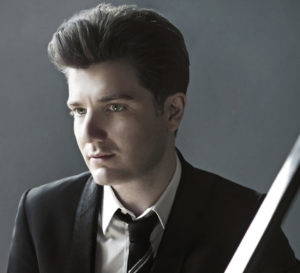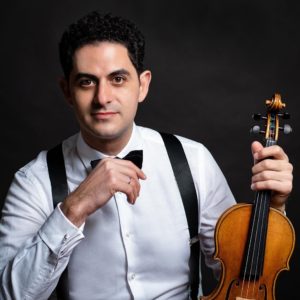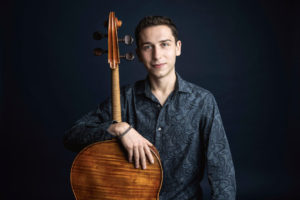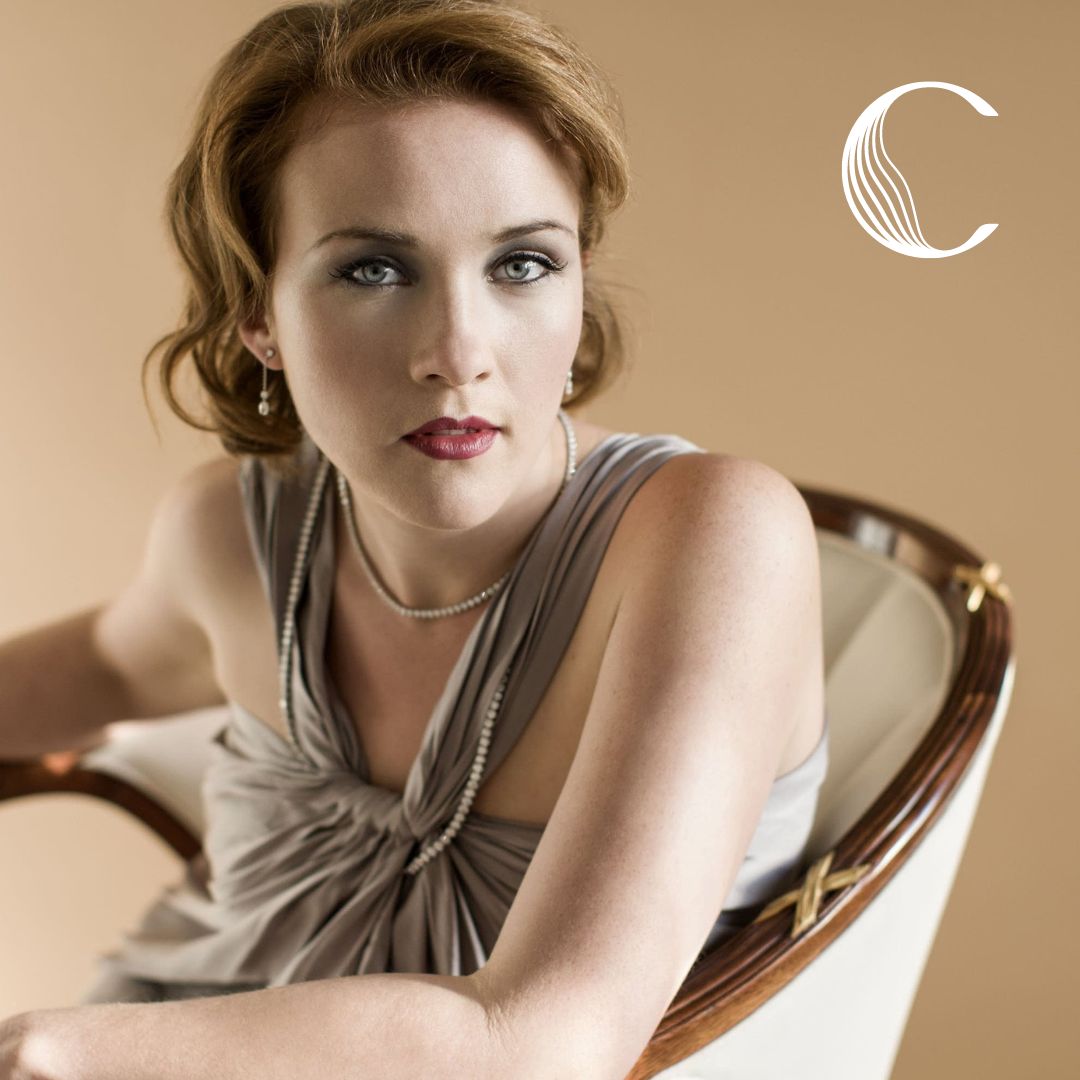The Schumanns: Clara and Robert
Pianist Alessio Bax debuts and cellist Oliver Herbert returns to join Arnaud Sussmann in trios by husband and wife pairing, the Schumanns.

Something Interesting
Clara Schumann was ahead of her time and regarded as one of the most distinguished pianists and pioneers of the Romantic era. She exerted her influence over the course of a 61-year concert career, shaping the format and repertoire of the piano recital. She also composed solo piano pieces, a piano concerto , chamber music, choral pieces, and songs.
Featured Artists
 Bax constantly explores many facets of his career. He released his eleventh Signum Classics album, Italian Inspirations, whose program was also the vehicle for his solo recital debut at New York’s 92nd Street Y as well as on tour. He recently debuted with the New York Philharmonic Orchestra, playing Schumann Concerto and the Seattle Symphony with Saint-Saëns’ Second Piano Concerto and embarked on a trio tour of Spain with violinist Joshua Bell and cellist Steven Isserlis. Bax and his regular piano duo partner, Lucille Chung, gave recitals at New York’s Lincoln Center and were featured with the St. Louis Symphony and Stéphane Denève. He has also toured extensively with Joshua Bell and presented the complete works of Beethoven for cello and piano with cellist Paul Watkins in New York City.
Bax constantly explores many facets of his career. He released his eleventh Signum Classics album, Italian Inspirations, whose program was also the vehicle for his solo recital debut at New York’s 92nd Street Y as well as on tour. He recently debuted with the New York Philharmonic Orchestra, playing Schumann Concerto and the Seattle Symphony with Saint-Saëns’ Second Piano Concerto and embarked on a trio tour of Spain with violinist Joshua Bell and cellist Steven Isserlis. Bax and his regular piano duo partner, Lucille Chung, gave recitals at New York’s Lincoln Center and were featured with the St. Louis Symphony and Stéphane Denève. He has also toured extensively with Joshua Bell and presented the complete works of Beethoven for cello and piano with cellist Paul Watkins in New York City.
Bax revisited Mozart’s K. 491 and K. 595 concertos, as heard on Alessio Bax Plays Mozart, for his recent debuts with the Boston and Melbourne Symphonies, both with Sir Andrew Davis, and with the Sydney Symphony, which he led himself from the keyboard. In addition, Bax made his solo recital debut at London’s Wigmore Hall, and give concerts at L.A.’s Disney Hall, Washington’s Kennedy Center, and New York’s Carnegie Hall.
As a renowned chamber musician, he recently collaborated with Joshua Bell, Ian Bostridge, Lucille Chung, Steven Isserlis, Daishin Kashimoto, Sergei Nakariakov, Emmanuel Pahud, Lawrence Power, Jean- Guihen Queyras, Paul Watkins and Tabea Zimmermann.
Since 2017 he has been the Artistic Director of the Incontri in Terra di Siena Festival, a Summer Music Festival in the Val d’Orcia region of Tuscany. He appears regularly in festivals such as Seattle, Bravo Vail, Salon-de-Provence, Le Pont in Japan, Great Lakes, Verbier, Ravinia and Music@Menlo.
In 2009, he was awarded an Avery Fisher Career Grant, and four years later he received both the Andrew Wolf Chamber Music Award and the Lincoln Center Award for Emerging Artists.
Bax’s celebrated Signum Classics discography includes Beethoven’s “Hammerklavier” and “Moonlight” Sonatas (a Gramophone “Editor’s Choice”); Beethoven’s “Emperor” Concerto; Bax & Chung, a duo disc with Lucille Chung; Alessio Bax plays Mozart, recorded with London’s Southbank Sinfonia; Alessio Bax: Scriabin & Mussorgsky (named “Recording of the Month ... and quite possibly ... of the year” by MusicWeb International); Alessio Bax plays Brahms (a Gramophone “Critics’ Choice”); Bach Transcribed; and Rachmaninov: Preludes & Melodies (an American Record Guide “Critics’ Choice 2011”). Recorded for Warner Classics, his Baroque Reflections album was also a Gramophone “Editor’s Choice.” He performed Beethoven’s “Hammerklavier” Sonata for Daniel Barenboim in the PBS-TV documentary Barenboim on Beethoven: Masterclass, available on DVD from EMI.
At the record age of 14, Bax graduated with top honors from the conservatory of Bari, his hometown in Italy, and after further studies in Europe, he moved to the United States in 1994. A Steinway artist, he lives in New York City with pianist Lucille Chung and their daughter, Mila. He was invited to join the piano faculty of Boston’s New England Conservatory in the fall of 2019.
 Winner of a 2009 Avery Fisher Career Grant, Arnaud Sussmann has distinguished himself with his unique sound, bravura, and profound musicianship. Minnesota’s Pioneer Press writes, “Sussmann has an old-school sound reminiscent of vintage recordings by Jascha Heifetz or Fritz Kreisler, a rare combination of sweet and smooth that can hypnotize a listener.”
Winner of a 2009 Avery Fisher Career Grant, Arnaud Sussmann has distinguished himself with his unique sound, bravura, and profound musicianship. Minnesota’s Pioneer Press writes, “Sussmann has an old-school sound reminiscent of vintage recordings by Jascha Heifetz or Fritz Kreisler, a rare combination of sweet and smooth that can hypnotize a listener.”
Mr. Sussmann he has recently appeared as a soloist with the Mariinsky Orchestra under Valery Gergiev, and the Vancouver, and New World Symphonies. As a chamber musician, he has performed at the Tel Aviv Museum, London’s Wigmore Hall, Lincoln Center, and the White Nights Festival in Saint Petersburg. He has also given concerts at the Caramoor, Music@Menlo, La Jolla SummerFest, Mainly Mozart, and Seattle Chamber Music festivals, collaborating with many of today’s leading artists including Itzhak Perlman, Shmuel Ashkenasi, Wu Han, David Finckel, and Jan Vogler.
Sussmann is Artistic Director of the Chamber Music Society of Palm Beach, Co-Director of Music@Menlo’s International Program, and teaches at Stony Brook University.
 Cellist Oliver Herbert is quickly building a reputation as an artist with a distinct voice and individual style, admired by audiences for his communicative and connective performances. The recipient of a 2021 Avery Fisher Career Grant, Oliver has been praised by San Francisco Classical Voice for his “expansive tone, virtuosity, and musical instincts.” Recent appearances include debuts with world renowned ensembles including the San Francisco Symphony, Chicago Symphony Orchestra, New World Symphony, Warsaw Philharmonic, and Edmonton Symphony Orchestra.
Cellist Oliver Herbert is quickly building a reputation as an artist with a distinct voice and individual style, admired by audiences for his communicative and connective performances. The recipient of a 2021 Avery Fisher Career Grant, Oliver has been praised by San Francisco Classical Voice for his “expansive tone, virtuosity, and musical instincts.” Recent appearances include debuts with world renowned ensembles including the San Francisco Symphony, Chicago Symphony Orchestra, New World Symphony, Warsaw Philharmonic, and Edmonton Symphony Orchestra.
As a chamber musician and recitalist, Oliver has performed at leading music festivals including Caramoor, ChamberFest Cleveland, Krzyżowa Music, La Jolla Summerfest, Marlboro Music, Music in the Vineyards, Nevada Chamber Music Festival, Ravinia, Rheingau, and Verbier. In the 2021-22 season, Oliver joins violinist Alexi Kenney and pianist Eric Lu for a program of Haydn, Schumann, and Schubert at the Philadelphia Chamber Music Society.
Born in San Francisco, Oliver is a graduate of the Curtis Institute of Music and the Colburn School where he studied with Carter Brey, Clive Greensmith, and Peter Wiley. Additional mentors include Pamela Frank and Dr. Ford Lallerstedt at the Curtis Institute. His competition awards include top prizes in the Lutoslawski International Cello Competition, Klein Competition, and Stulberg Competition. Additionally, Oliver is the winner of the Jean-Nicolas Firmenich Prize at the 2017 Verbier Festival. He currently plays on a Guadagnini cello that belonged to the great Italian cellist Antonio Janigro, on generous loan from the Janigro family.
About The Music

Growing up in the musically fertile city of Leipzig, Clara Wieck—the future Clara Schumann (1819-1896)—blazed through a rigorous curriculum of piano, composition and ear training devised by her father. Clara made her public debut at age nine, the same year an 18-year-old law student with musical inclinations, Robert Schumann, moved into the Wieck household to take intensive piano lessons. His piano career fizzled out after a hand injury, but 11 years after he was first enchanted by Clara’s talents (and after overcoming a bitter and protracted legal battle with her father), the struggling composer and journal editor, Robert, was able to marry the budding superstar pianist, Clara.
Clara found a way to keep up a concert career while raising children and caretaking her mentally ill husband, but she never resumed the pace of composing that peaked during her teenage years. Though small in quantity, the works from her married years are superb in quality, a sign of the high level of musical discourse and mutual respect in the Schumann family. The Piano Trio in G Minor from 1846 was the first of only two works of chamber music she ever completed, but a lifetime of playing chamber music made her an expert from the start. She had the benefit of close contact in Leipzig with Felix Mendelssohn, a champion of Baroque and Classical styles who tended the flames of 18th-century counterpoint and clarity when few others cared to do so, including an effort to revive trios for violin, cello and piano that had fallen out of fashion after the time of Beethoven. Clara also joined her husband in a deep study of Bach in the period right before she composed the trio, and her skill in contrapuntal layering helped her devise chamber music textures that allow all three instruments to shine.
After a well-argued first movement in the traditional sonata-allegro form, the Scherzo comes second, making great fun out of its hiccupping rhythmic pattern known as the “Scotch snap.” The Andante third movement is especially gorgeous and tuneful, pointing to her skills as a songwriter that were every bit the match of Robert’s. Brief bursts of fugal counterpoint in the Allegretto finale shows how well Schumann married the intellectual and emotional tools at her disposal to craft a deeply affecting work.
Program Notes by Aaron Grad
© 2023 Aaron Grad.

Robert Schumann (1810-1856), amid a lifelong struggle to maintain his mental health, reached a particularly low point in 1844, when he experienced debilitating symptoms of insomnia, phobias, exhaustion, paranoia and auditory hallucinations. As he emerged, he found that the flow of music that had once come so naturally could no longer be taken for granted. He later wrote in a diary, “I used to compose almost all of my shorter pieces in the heat of inspiration. … Only from the year 1845 onwards, when I started to work out everything in my head, did a completely new manner of composing begin to develop.”
Schumann was back in peak form by 1847, when he composed two piano trios that demonstrated the renewed rigor and cohesion of his craft. One key was his embrace of counterpoint, inspired by a deep study of the music of J. S. Bach. A prime example comes at the start of the Piano Trio No. 1 in D Minor; instead of placing the violin’s theme over a subservient accompaniment, the piano’s left hand contributes an equally important bass line, and the cello fills in the middle range with its own counter-line. Still, this new approach did not neutralize that poetic aspect of Schumann, the quality that fueled his hundreds of songs and instrumental miniatures. One particularly sublime moment comes in the first movement’s development section, when the strings play delicate strands of melody near the bridge, creating a quiet, glassy sound.
Another source of inspiration for Schumann was the piano trio in the same key composed eight years earlier by his friend Felix Mendelssohn. Schumann’s lively second movement dances with a sturdier gait than Mendelssohn’s tiptoeing Scherzo, but each serves as a joyful diversion within an otherwise profound trio.
Yet one more undeniable influence on Schumann was his wife, Clara, the piano virtuoso who wrote her own splendid Piano Trio in G Minor a year before Robert took up the genre. The third movement, to be played “Slowly, with intimate feeling,” attests to the sensitive and openhearted artistry that Schumann explored within one of music’s sweetest partnerships.
The finale’s tempo marking is “With fire,” and it only burns hotter as the closing coda gradually accelerates. The careful interweaving of contrapuntal voices, a hallmark of this trio from its first notes, continues all the way to the final cadence.
Program Notes by Aaron Grad
© 2023 Aaron Grad.
CMSPB does not discriminate on the basis of race, gender, creed, ethnicity, religion, sexual orientation, age or disability and we are a 501(c)(3) nonprofit organization.
Site maintained by Teller | © 2020-2022 Chamber Music Society of Palm Beach | All rights reserved.
